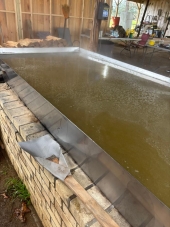
 9
9




 2
2










positively optimistic 🙂 https://www.youtube.com/@613Builds
 5
5








How permies.com works
What is a Mother Tree ?

 1
1




Ask me about food.
How Permies.com Works (lots of useful links)









 2
2




 3
3




Projects, plans, resources - now on the Permies.com digital marketplace.
Try the Everything Combo as a reference guide.
 3
3




I have to slightly disagree here. I understand what you are saying and I agree this is true on some levels especially in a RMH however in an evaporator I believe there is a drop of point at some point where more wood doesn't gain you much more boiling rate. Water can only boil so vigorously and release heat into steam so quickly and at some point more heat does not any longer give you more boiling and I believe you risk burning your product. If you built in such a way that the unit could somehow store the excess heat in reserve like a rocket mass heater then this principle might work but you would be talking about needing to store heat in excess of 219 degrees (the boiling point of syrup). I seem to be getting a boil rate of about 1 gallon per square foot of surface area per hour which is right on par with what the big oil fired professional rigs run at so I am fairly happy with that. I am not sure how much adding more heat would help increase this. I am friends with some guys with large operations (9000+ taps) basically they seem to say they can do lots to increase efficiency (use less oil) but very little to decrease boil time as that is fairly well fixed based on surface area.The amount of wood you can burn roughly corresponds to power output - IF the wood and its heat are being used efficiently; wasted wood doesn't correspond to anything.




John McDoodle wrote:Yes post the videos !

We have sugar maples here and i was also debating on tapping a few- i could reduce it on my rocket also - but im new to tapping.
Praying my way through the day





 1
1




 2
2




 1
1




 1
1




Jim Peabbles wrote:Jeff, are you still using this design?





 2
2

























